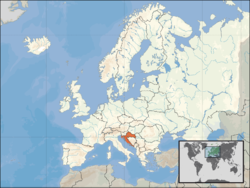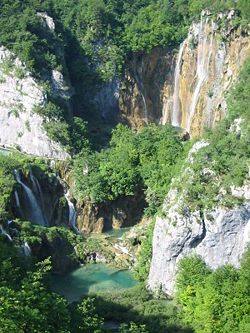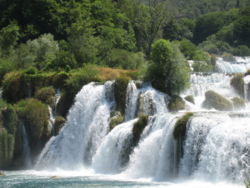Croatia
2008/9 Schools Wikipedia Selection. Related subjects: Europe; European Countries
| Republika Hrvatska Republic of Croatia
|
||||||
|---|---|---|---|---|---|---|
|
||||||
| Anthem: Lijepa naša domovino Our beautiful homeland |
||||||
|
Location of Croatia (orange)
on the European continent (white) — [ Legend] |
||||||
| Capital (and largest city) |
Zagreb |
|||||
| Official languages | Croatian | |||||
| Demonym | Croat(s) Croatian(s) |
|||||
| Government | Parliamentary republic | |||||
| - | President | Stjepan Mesić | ||||
| - | Premier | Ivo Sanader | ||||
| Establishment | ||||||
| - | Founded | First half of 7th century | ||||
| - | Medieval duchy | March 4, 852 | ||||
| - | Independence | May 21, 879 | ||||
| - | Elevated to kingdom | 925 | ||||
| - | Union with Hungary | 1102 | ||||
| - | Joined Habsburg Empire | January 1, 1527 | ||||
| - | Independence from Austria-Hungary |
October 29, 1918 |
||||
| - | Joined Yugoslavia (co-creator) |
December 1, 1918 |
||||
| - | Declared independence | June 25, 1991 | ||||
| Area | ||||||
| - | Total | 56,542 km² ( 126th) 21,831 sq mi |
||||
| - | Water (%) | 0.2 | ||||
| Population | ||||||
| - | Sep 2007 estimate | 4,440,690 ( 114th) | ||||
| - | 2001 census | 4,437,460 | ||||
| - | Density | 81/km² ( 109th) 208/sq mi |
||||
| GDP ( PPP) | Sep 2007 estimate | |||||
| - | Total | $66.708 billion ( ) ( 68th) | ||||
| - | Per capita | 18,817 ( ) ( 50th) | ||||
| GDP (nominal) | Sep 2007 estimate | |||||
| - | Total | $66.708 billion (EIU) | ||||
| - | Per capita | $11,771 (IMF) | ||||
| Gini (2005) | 29 (low) | |||||
| HDI (2005) | ▲ 0.850 (high) ( 47th) | |||||
| Currency | kuna ( HRK) |
|||||
| Time zone | CET ( UTC+1) | |||||
| - | Summer ( DST) | CEST ( UTC+2) | ||||
| Internet TLD | .hr | |||||
| Calling code | +385 | |||||
| 1 | Also Italian in Istria and languages of other national minorities ( Serbian, Hungarian, Czech, Slovak, etc.) in residential municipalities of the national minorities. | |||||
Croatia (IPA: /kroʊˈeɪʃə/) ( Croatian: Hrvatska), officially the Republic of Croatia (Republika Hrvatska listen ), is a country at the crossroads of the Mediterranean, Central Europe, and the Balkans. Its capital is Zagreb. Croatia borders with Slovenia and Hungary to the north, Serbia to the northeast, Bosnia and Herzegovina to the east, Montenegro to the far southeast, and the Adriatic Sea to the south. Croatia is a candidate for membership of the European Union and is expecting NATO membership invitation in April 2008. On October 17, 2007 Croatia became a non-permanent member of the United Nations Security Council for the 2008-2009 term.
History
The Croats settled in the Mediterranean in the early 7th century and formed two principalities: Dalmatia and Pannonia. The establishment of the Trpimirović dynasty, circa 850, strengthened the Dalmatian Croat Duchy, which together with the Pannonian principality became a Kingdom in 925 under King Tomislav I.
In 1102, Croatia entered into a personal union with the Hungarian Kingdom. After the 1526 Battle of Mohács the "reliquiae reliquiarum" (remnants of the remnants) of Croatia became a part of the Habsburg Monarchy in 1527.
Croatia was part of the Kingdom of Serbs, Croats and Slovenes, from 1918-1929, and Kingdom of Yugoslavia, from 1929-1941. In 1941-1945, a union known as the Independent State of Croatia was set up, and after the victory of the Yugoslav Partisans led by Josip Broz Tito, a half- Croatian, half-Slovenian, Croatia became a republic within Yugoslavia.
In 1991 Croatia declared independence and a bitter and costly war was fought by the Croatian government against the Milošević - led Yugoslav People's Army, Serbian paramilitary forces and rebel Serbs from Croatia who wanted to create "Great Serbia" from Croatian and Bosnian and Herzegovian territory. Later, the war turned into a conflict between the Republic of Croatia and the rebel Serbs who occupied Croatian territory. The war came to an end with a Croatian victory, liberating the lost territory and its constitution to the state before war started, which made possible signing of the Dayton Agreement in 1995 by all war sides, that gave peace in the neighbouring Bosnia and Herzegovina.
Geography
Croatia is located in South-Central Europe. Its shape resembles that of a crescent or a horseshoe, which flanks its neighbours Serbia, Bosnia and Herzegovina and Montenegro. To the north lie Slovenia and Hungary; Italy lies across the Adriatic Sea. Its mainland territory is split in two non-contiguous parts by the short coastline of Bosnia and Herzegovina around Neum.
Its terrain is diverse, including:
- plains, lakes and rolling hills in the continental north and northeast (Central Croatia and Slavonia, part of the Pannonian Basin);
- densely wooded mountains in Lika and Gorski Kotar, part of the Dinaric Alps;
- rocky coastlines on the Adriatic Sea ( Istria, Northern Seacoast and Dalmatia).
The country is famous for its many national parks. Croatia has a mixture of climates. In the north and east it is continental, Mediterranean along the coast and a semi-highland and highland climate in the south-central region. Offshore Croatia consists of over one thousand islands varying in size.
Politics
Since the adoption of the 1990 Constitution, Croatia has been a democratic republic. Between 1990 and 2000 it had a semi-presidential system, and since 2000 it has a parliamentary system.
The President of the Republic (Predsjednik) is the head of state, directly elected to a five-year term and is limited by the Constitution to a maximum of two terms. In addition to being the commander in chief of the armed forces, the president has the procedural duty of appointing the Prime minister with the consent of the Parliament, and has some influence on foreign policy. His official residence is Predsjednički dvori. Apart from that he has summer residences on the islands of Vanga (Brijuni islands) and the island of Hvar.
Template:Croatia membership The Croatian Parliament (Sabor) is a unicameral legislative body (a second chamber, the "House of Counties", which was set up by the Constitution of 1990, was abolished in 2001). The number of the Sabor's members can vary from 100 to 160; they are all elected by popular vote to serve four-year terms. The plenary sessions of the Sabor take place from January 15 to July 15, and from September 15 to December 15.
The Croatian Government (Vlada) is headed by the Prime minister who has two deputy prime ministers and fourteen ministers in charge of particular sectors of activity. The executive branch is responsible for proposing legislation and a budget, executing the laws, and guiding the foreign and internal policies of the republic. Government's official residence is at Banski dvori.
Croatia has a three-tiered judicial system, consisting of the Supreme Court, county courts, and municipal courts. The Constitutional Court rules on matters regarding the Constitution.
Counties
Croatia is divided into twenty-one counties (županija) and the capital Zagreb's city district (in italics below):
| Anglicized name | Native name | |
| 1 | Zagreb | Zagrebačka |
| 2 | Krapina-Zagorje | Krapinsko-zagorska |
| 3 | Sisak-Moslavina | Sisačko-moslavačka |
| 4 | Karlovac | Karlovačka |
| 5 | Varaždin | Varaždinska |
| 6 | Koprivnica-Križevci | Koprivničko-križevačka |
| 7 | Bjelovar-Bilogora | Bjelovarsko-bilogorska |
| 8 | Primorje-Gorski Kotar | Primorsko-goranska |
| 9 | Lika-Senj | Ličko-senjska |
| 10 | Virovitica-Podravina | Virovitičko-podravska |
| 11 | Požega-Slavonia | Požeško-slavonska |
| 12 | Brod-Posavina | Brodsko-posavska |
| 13 | Zadar | Zadarska |
| 14 | Osijek-Baranja | Osječko-baranjska |
| 15 | Šibenik-Knin | Šibensko-kninska |
| 16 | Vukovar-Srijem | Vukovarsko-srijemska |
| 17 | Split-Dalmatia | Splitsko-dalmatinska |
| 18 | Istria | Istarska |
| 19 | Dubrovnik-Neretva | Dubrovačko-neretvanska |
| 20 | Međimurje | Međimurska |
| 21 | City of Zagreb | Grad Zagreb |
Economy
The Croatian economy has a stable functioning market economy according to EU reports and is the most advanced economy of South-Eastern Europe (Greece excluded). The Croatian preliminary 2008 GDP data states that the Croatian GDP is USD 66.7 billion, or just over USD 18,800 per capita ( real income), putting Croatia ahead of the EU member-states Romania, Bulgaria, Poland and Lithuania. "Grey" economy of about USD 2 billion is still not included in GDP calculations like in other EU countries, something which would certainly increase it. Average net salary is cca. USD 1000. After Slovenia this is the highest net salary per capita of all transition countries.
The economic output is distributed as follows: Agriculture 6%, industry 27% and service sector 67%. The industrial sector is dominated by shipbuilding, food processing and the chemical industry. Tourism is a notable source of income during the summer. With over 10,0 million foreign tourists in 2006 generating a revenue of EUR 7 billion, Croatia is ranked as the 18th most popular tourist destination in the world. In 2006 Croatia exported goods in value of USD 10.4 billion ( FOB) (19.7 billion including service exports).
Unemployment is at 9,1% ( International Labour Organization figures) in 2007. Of particular concern is the backlogged judiciary system, combined with inefficient public administration, especially issues of land ownership and corruption. Another main problem includes the large and growing national debt which has reached over 35 billion dollars.
The country has been preparing for membership in the European Union, its most important trading partner. In February 2005, the Stabilization and Association Agreement with the EU officially came into force.
In the first quarter of 2007, Croatian economy rose by 7.1%, in second quarter 6.6% so the annual growth rate which was expected to be around 4.7% has now been revised to 6.5% or more. Analysts believe that the Croatian economy, after modest growth of around 4.5% so far, is finally entering a period of faster and stronger economic prosperity.
Demographics
The population of Croatia has been stagnating over the last decade. The 1991–1995 war in Croatia had previously displaced large parts of the population and increased emigration. Most Serbs fled the country in the last stage of the war. Some Croats who also fled the country during the war are returning. The natural growth rate is minute or negative (less than ± 1%), as the demographic transition has been completed half a century ago. Average life expectancy is approximately 75 years, and the literacy rate is 98.5%.
Croatia is inhabited mostly by Croats (89.9%). There are around twenty minorities, Serbs though they were much larger before war, being the largest one (4.5%) and others having less than 0.5% each. The predominant religion is Catholicism (87.8%), with some Orthodox (4.4%) and Sunni Muslim (1.3%) minorities.
The official and common language, Croatian, is a South Slavic language, using the Latin alphabet. Less than 5% of the population cites other languages as their mother tongues.
Culture
Croatian culture is the result of a thirteen century-long history which has seen the development of many cities and monuments. The country includes six World Heritage sites and eight national parks. Croatia is also the birthplace of a number of historical figures included among the notable people are three Nobel prize winners, and numerous inventors.
Some of the world's first fountain pens came from Croatia. Croatia also has a place in the history of clothing as the origin of the necktie (cravat). The country has a long artistic, literary and musical tradition. Also of interest is the diverse nature of Croatian cuisine.







